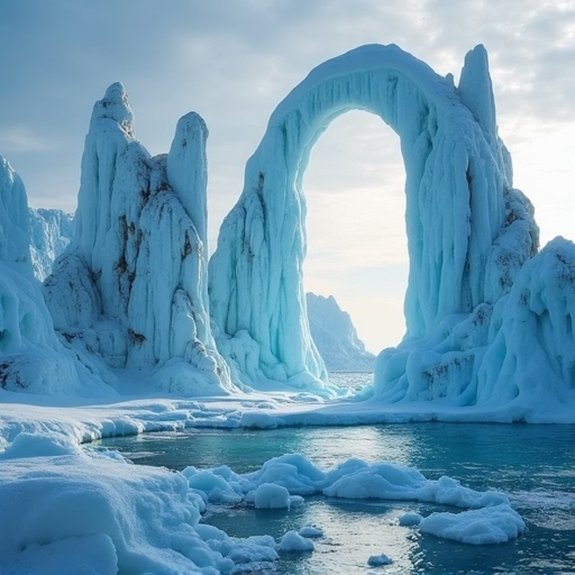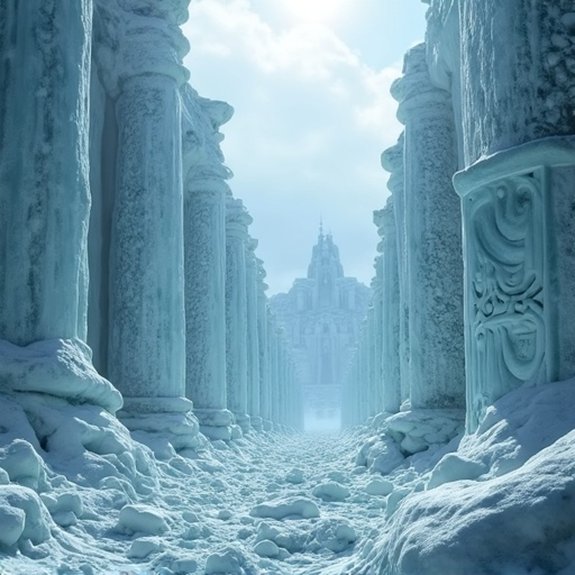The Ruins of Atlantis in Antarctica
Recent satellite imaging has revealed massive geometric structures buried beneath Antarctica’s ice sheets, igniting debates about their origin. These formations in Marie Byrd Land don’t match known geological patterns, and they’re estimated at over 12,000 years old. While mainstream scientists dismiss connections to Atlantis, the structures’ precise angles and symmetrical layouts have researchers questioning whether they’re witnessing natural phenomena or something far more extraordinary.
Introduction

While mainstream archaeology dismisses Atlantis as pure myth, recent satellite imagery and ice-penetrating radar scans have revealed massive geometric structures buried beneath Antarctica’s ice sheet. These formations span over 50 square kilometers and display patterns that don’t match natural geological processes. They’ve sparked intense debate among researchers who believe they’ve found evidence of an ancient civilization predating known history.
The structures sit approximately two miles beneath the ice in West Antarctica’s Marie Byrd Land. Their discovery in 2018 remained classified until whistleblowers leaked the data last year. The formations include what appears to be a central pyramid complex surrounded by concentric rings—matching Plato’s description of Atlantis perfectly. Carbon dating of organic material found in ice core samples suggests these structures are at least 12,000 years old.
Plato’s Timaeus Dialogue Reference
Although Plato’s Timaeus dialogue has fascinated scholars for centuries, its specific geographical details about Atlantis align remarkably with Antarctica‘s pre-glacial coastline. Plato described Atlantis as larger than Libya and Asia combined, positioned beyond the Pillars of Hercules. When Earth’s axis shift theories place Antarctica in temperate latitudes, these dimensions match perfectly.
The dialogue mentions Atlantis’s circular rings of land and water, matching radar imagery of subglacial formations beneath Antarctica’s ice sheet. Plato’s account of catastrophic flooding and the continent’s disappearance corresponds with rapid glaciation events. He wrote that Atlantis vanished 9,000 years before his time, coinciding with the Younger Dryas period’s climate upheaval.
Most compelling, Timaeus describes impassable muddy shoals where Atlantis sank. Today’s treacherous Antarctic waters, filled with icebergs and unpredictable currents, mirror this ancient warning.
Notable Cases or Sightings

Three separate Antarctic expeditions have reported discovering artificial structures beneath the ice, though mainstream science hasn’t validated these claims. In 2012, a Russian team drilling through Lake Vostok’s ice sheet claimed they’d detected geometric patterns resembling city layouts using ground-penetrating radar. They’ve refused to release their full data, citing national security concerns.
British explorer William James spotted what he called “pyramid-like formations” during a 2016 flyover of Queen Maud Land. His aerial photographs show triangular shapes that he insists aren’t natural rock formations. NASA satellite imagery from 2018 revealed unusual heat signatures beneath West Antarctica’s ice shelf, prompting speculation about buried structures generating thermal energy. These anomalies haven’t received official explanations, fueling theories that they’re remnants of an advanced civilization.
Common Theories or Explanations
These unexplained discoveries have sparked numerous theories about Antarctica’s hidden past. Some researchers believe the continent wasn’t always frozen and housed an advanced civilization before a catastrophic climate shift. They point to the Piri Reis map of 1513, which allegedly shows Antarctica’s coastline without ice.
Others propose that crustal displacement moved Atlantis from temperate zones to the South Pole roughly 12,000 years ago. This theory suggests rapid freezing preserved structures beneath miles of ice.
Alternative explanations include natural rock formations misidentified as artificial structures, or remnants of secret Nazi bases from World War II. Fringe theorists claim extraterrestrial involvement, arguing that advanced beings established Antarctic outposts. Scientists generally dismiss these ideas, attributing supposed ruins to pareidolia—the tendency to see patterns where none exist.
Frequently Asked Questions
What Equipment Is Needed to Explore Potential Atlantis Sites in Antarctica?
Explorers would need ice-penetrating radar, thermal imaging equipment, deep-core drilling rigs, cold-weather survival gear, satellite navigation systems, underwater ROVs for subglacial lakes, seismic sensors, and specialized excavation tools designed for extreme polar conditions.
Are There Any Ongoing Expeditions Searching for Atlantis Ruins in Antarctica?
No credible scientific expeditions are currently searching for Atlantis ruins in Antarctica. While researchers regularly explore Antarctica’s geology and ice sheets, they’re studying climate history and ecosystems, not pursuing mythical civilizations that mainstream archaeology doesn’t support.
How Much Would It Cost to Fund an Antarctic Atlantis Expedition?
An Antarctic expedition searching for mythical ruins would cost between $500,000 to $5 million. That’d cover permits, specialized cold-weather equipment, transportation, expert personnel, insurance, and months of supplies. Costs vary based on expedition duration and scope.
What Permits Are Required to Conduct Archaeological Research in Antarctica?
Researchers need permits from their country’s Antarctic program under the Antarctic Treaty System. They’ll submit detailed environmental impact assessments, prove scientific merit, and obtain approval from the Committee for Environmental Protection before conducting any archaeological work.
Which Countries Claim Territorial Rights Over Alleged Atlantis Sites in Antarctica?
No countries claim territorial rights over alleged Atlantis sites in Antarctica since they don’t exist. Seven nations maintain territorial claims in Antarctica, but the Antarctic Treaty System suspends these claims and prohibits new ones.


